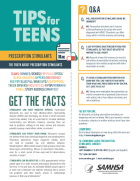This 18x24 inch poster helps publicize youth suicide warning signs and provides access to a life-saving resource; the 988 Suicide & Crisis Lifeline. This poster is designed to be placed in school counseling offices, clinics, pediatrician offices, and other settings relevant to families.
Dashboard: Filter Bricks
Main page content


A poster encouraging parents to work with student assistance professionals when they are concerned about their child’s health and wellbeing.

This chartbook uses combined 2015 to 2019 data from the National Survey on Drug Use and Health (NSDUH) to present nationally representative estimates of mental health service utilization among adults aged 18 or older and adolescents aged 12 to 17 within different racial/ethnic groups in the United States. The percentages are annual averages.

This flyer provides information and tips for coping during a pandemic as well as resources for additional assistance.

This fact sheet for teens provides facts about HIV. It includes information about how the virus is spread and how to prevent transmission and answers common questions. It can be used by prevention professionals, educators, health care providers, and others who come in contact with teens.

This fact sheet for teens provides facts about sedatives. It describes short- and long-term effects, lists signs of use, and helps dispel common myths. It also can be used by prevention professionals, educators, health care providers, and others who come in contact with teens on a regular basis.

This fact sheet for teens provides facts about stimulants. It describes short- and long-term effects, lists signs of use, and helps dispel common myths. It also can be used by prevention professionals, educators, health care providers, and others who come in contact with teens on a regular basis.

This fact sheet for teens provides facts about hallucinogens. It describes short- and long-term effects, lists signs of use, and helps dispel common myths. It also can be used by prevention professionals, educators, health care providers, and others who come in contact with teens on a regular basis.

This fact sheet for teens provides facts about opioids. It describes short- and long-term effects and lists signs of opioid use. The fact sheet helps to dispel common myths about opioids. Access sources cited in this fact sheet

This planning guide and resource calendar helps communities plan and implement their National Prevention Week (NPW) 2019 activities. In addition to information on health observances and SAMHSA resources, the guide includes quarterly checklists, planning tips, and introductions to NPW’s federal partners. This year’s calendar also features Augmented Reality (AR), so the calendar can come alive for users after they download a free app for their mobile device.
Displaying 1 - 10 out of 16

